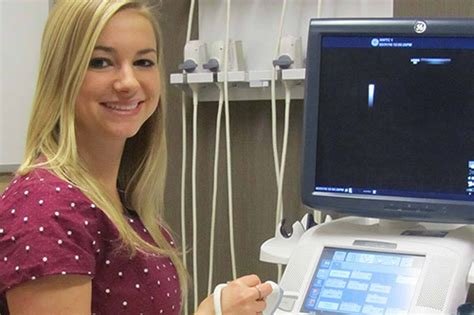Sonography, also known as ultrasound, is a non-invasive medical imaging technique that uses high-frequency sound waves to produce images of the body’s internal organs, tissues, and blood flow. Sonography is widely used in various medical fields, including obstetrics, cardiology, and abdominal imaging.

In Wisconsin, several reputable institutions and educational providers offer comprehensive sonography programs designed to train students in the principles and practices of diagnostic medical sonography. These programs prepare graduates to enter the field as skilled ultrasound technologists or sonographers.
Program Structure and Curriculum
Sonography programs in Wisconsin typically encompass a combination of classroom instruction, laboratory exercises, and clinical rotations. Students learn about the basic principles of ultrasound physics, instrumentation, anatomy, and physiology. They also receive hands-on training in sonographic techniques, including image acquisition, interpretation, and patient care.
The curriculum of a sonography program may vary slightly among institutions, but it generally covers topics such as:
- Ultrasound Physics and Instrumentation: Students study the underlying principles of sound wave propagation, image formation, and various ultrasound transducers.
- Anatomy and Physiology: In-depth knowledge of human anatomy and physiology is essential for understanding the structures and functions visualized during sonography examinations.
- Sonographic Techniques: Students master various scanning techniques, including transabdominal, transvaginal, and transcranial ultrasound. They learn to obtain high-quality diagnostic images of different body regions.
- Pathology: Sonographers must be able to recognize and interpret abnormalities in tissues and organs. The curriculum includes a thorough overview of sonographic findings associated with various diseases and conditions.
- Clinical Rotations: Supervised clinical rotations provide students with hands-on experience in a hospital or clinic setting. They work under the guidance of experienced sonographers and contribute to patient care.
Program Length and Accreditation
Sonography programs in Wisconsin typically last for two to three years, depending on the institution and the specific program design. Some programs offer associate degrees, while others award bachelor’s degrees.
Accreditation is an important consideration when evaluating sonography programs. Accredited programs have undergone rigorous peer review and have met established standards of quality. In Wisconsin, the following organization provides accreditation for sonography programs:
- Commission on Accreditation of Allied Health Education Programs (CAAHEP): CAAHEP-accredited programs ensure that graduates meet the knowledge and skill requirements for entry-level sonographers.
Career Outlook for Sonographers in Wisconsin
The demand for skilled sonographers is expected to grow in Wisconsin, as the aging population increases the need for diagnostic imaging services. According to the U.S. Bureau of Labor Statistics (BLS), the employment of diagnostic medical sonographers and cardiovascular technologists and technicians is projected to increase by 19% from 2021 to 2031.
In Wisconsin, the median annual salary for sonographers was $70,250 in May 2021, according to the BLS. The top 10% of earners made more than $102,730, while the bottom 10% earned less than $51,530.
Choosing a Sonography Program in Wisconsin
Prospective students considering a career in sonography should carefully evaluate different programs in Wisconsin based on factors such as:
- Accreditation: Choose a program that is accredited by CAAHEP.
- Program length and format: Consider the length and delivery format of the program (e.g., full-time, part-time, hybrid).
- Curriculum: Examine the curriculum to ensure that it covers essential topics and provides adequate clinical experience.
- Faculty and resources: Research the qualifications of the faculty and the availability of resources, such as a sonography lab and simulation equipment.
- Location and cost: Consider the program’s location and tuition costs, including any additional fees or estimated expenses.
Strategies for Success in Sonography
To succeed in a sonography program and the field, students should employ the following strategies:
- Attend classes regularly and participate actively: Engagement in lectures and lab sessions is crucial for comprehension.
- Prepare for exams thoroughly: Study lecture notes, textbooks, and practice questions diligently.
- Seek guidance from instructors and advisors: Utilize office hours and other opportunities to clarify concepts and receive support.
- Practice sonographic skills consistently: Develop proficiency in ultrasound machine operation and image acquisition techniques.
- Seek feedback and work on improvement: Regularly evaluate your performance and seek constructive criticism to enhance your skills.
- Join professional organizations and attend conferences: Network with other sonographers and stay abreast of the latest advancements in the field.
Frequently Asked Questions
1. What are the prerequisites for admission to a sonography program in Wisconsin?
Most programs require a high school diploma or equivalent and certain science and math prerequisites, such as biology, chemistry, physics, and algebra. Some programs may also require prior healthcare experience.
2. How much does a sonography program cost in Wisconsin?
Tuition costs vary among institutions and program formats. Contact the admissions office of each program for specific information.
3. What is the job outlook for sonographers in Wisconsin?
The demand for sonographers is expected to grow in Wisconsin, with ample job opportunities available.
4. What are the career advancement opportunities for sonographers?
With experience and additional training or education, sonographers can advance to leadership roles, such as lead sonographer or sonography manager. They can also specialize in specific areas of sonography, such as vascular technology or echocardiography.
5. What is the difference between a sonographer and a radiologist?
Sonographers are responsible for performing and interpreting ultrasound examinations. Radiologists are physicians who specialize in interpreting all types of medical images, including ultrasound, X-rays, and MRI.
6. What technologies are shaping the future of sonography?
Advancements in artificial intelligence (AI), 3D ultrasound, and contrast-enhanced ultrasound are transforming the field of sonography, offering new possibilities for enhanced image quality and diagnostic precision.
7. What should I look for in a sonography program?
Consider accreditation, curriculum comprehensiveness, faculty credentials, clinical rotations, and student support services.
8. How can I prepare for a career in sonography?
Volunteer or gain experience in a healthcare setting, shadow sonographers, and develop a strong foundation in anatomy and physiology.
